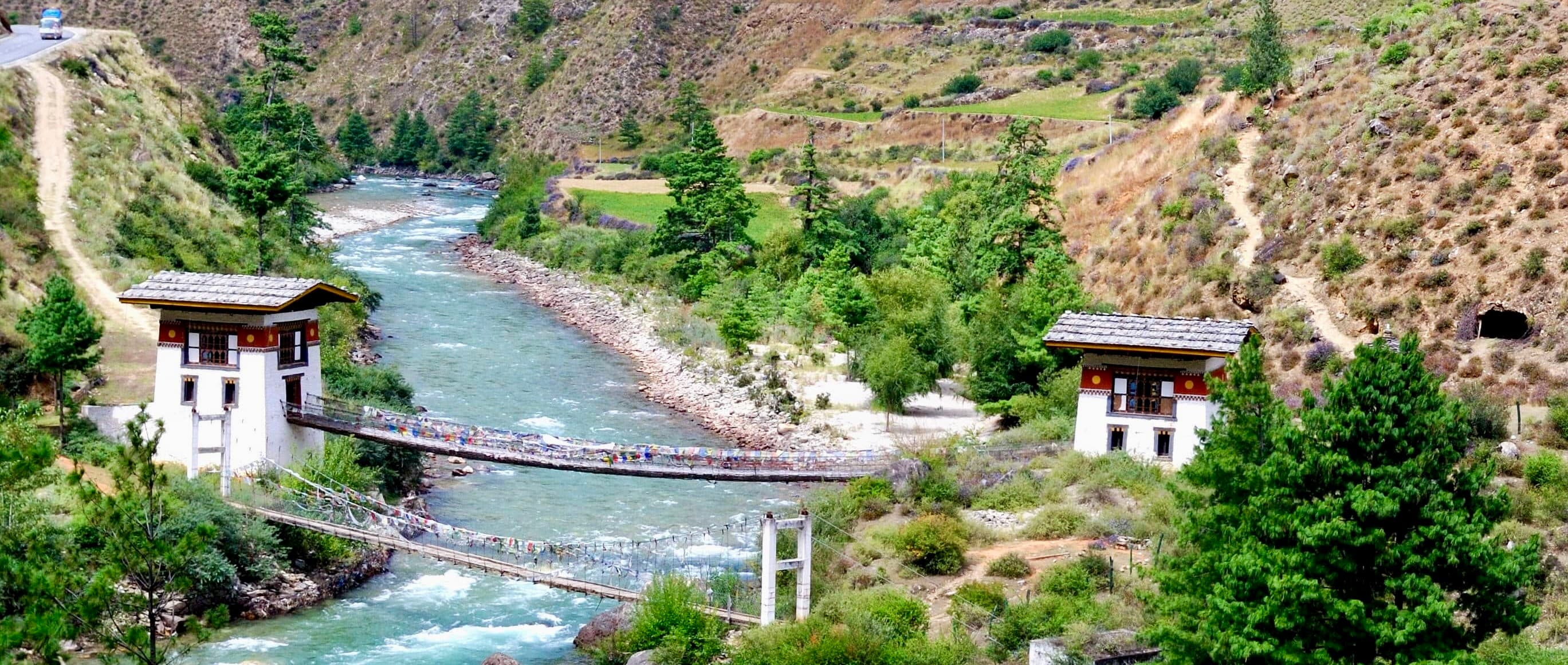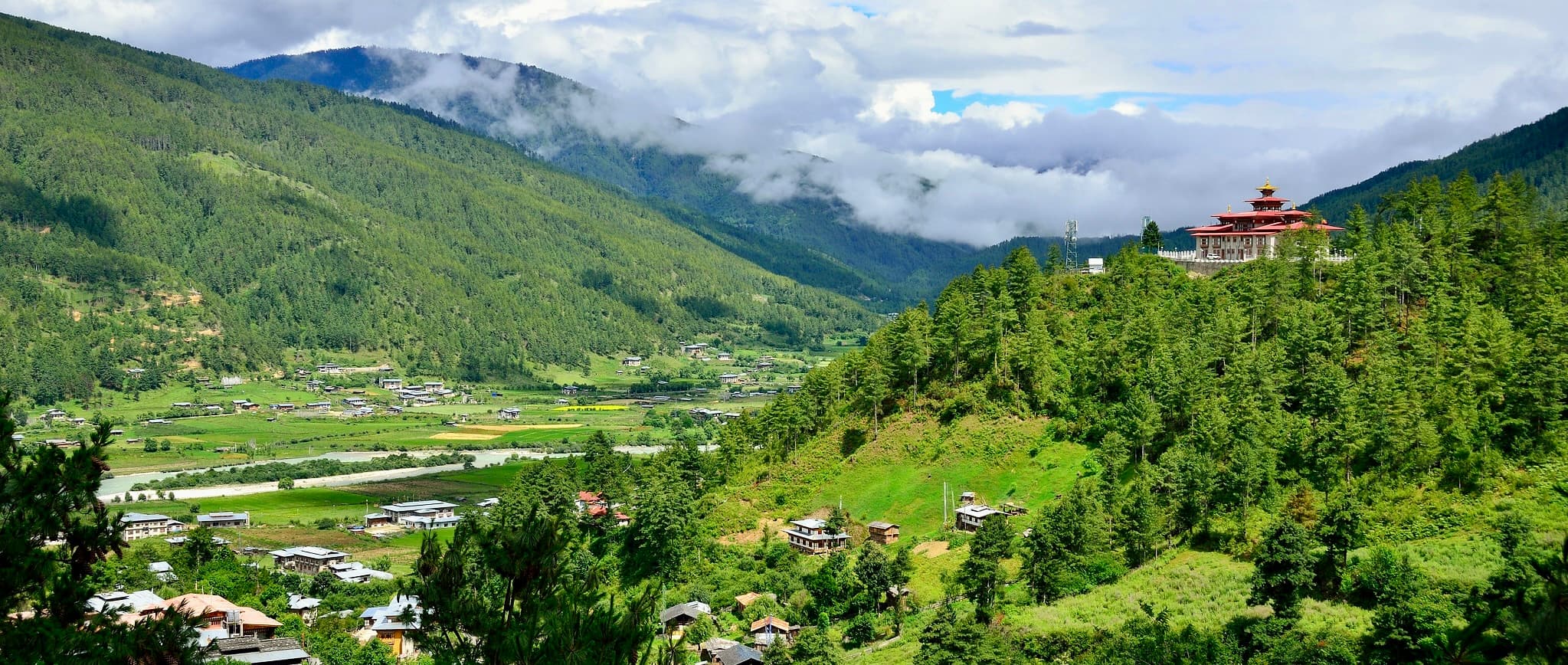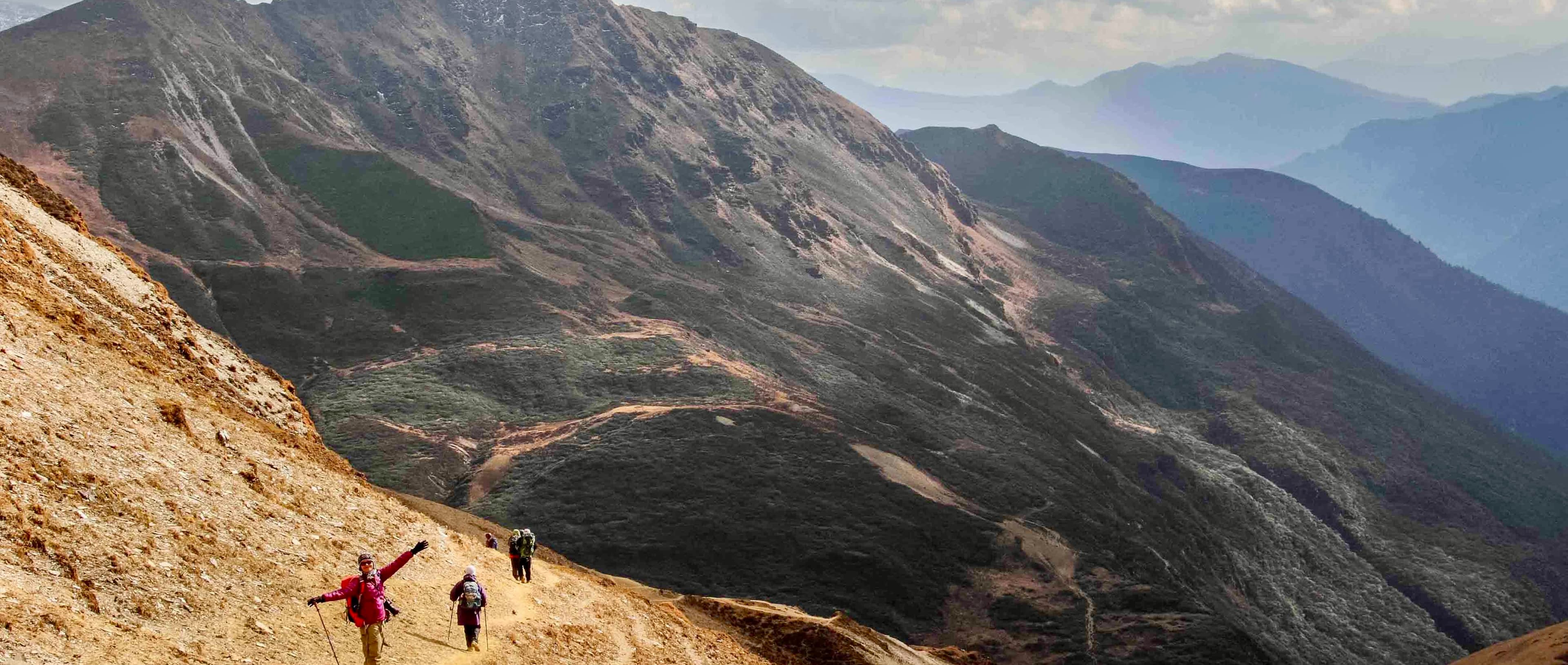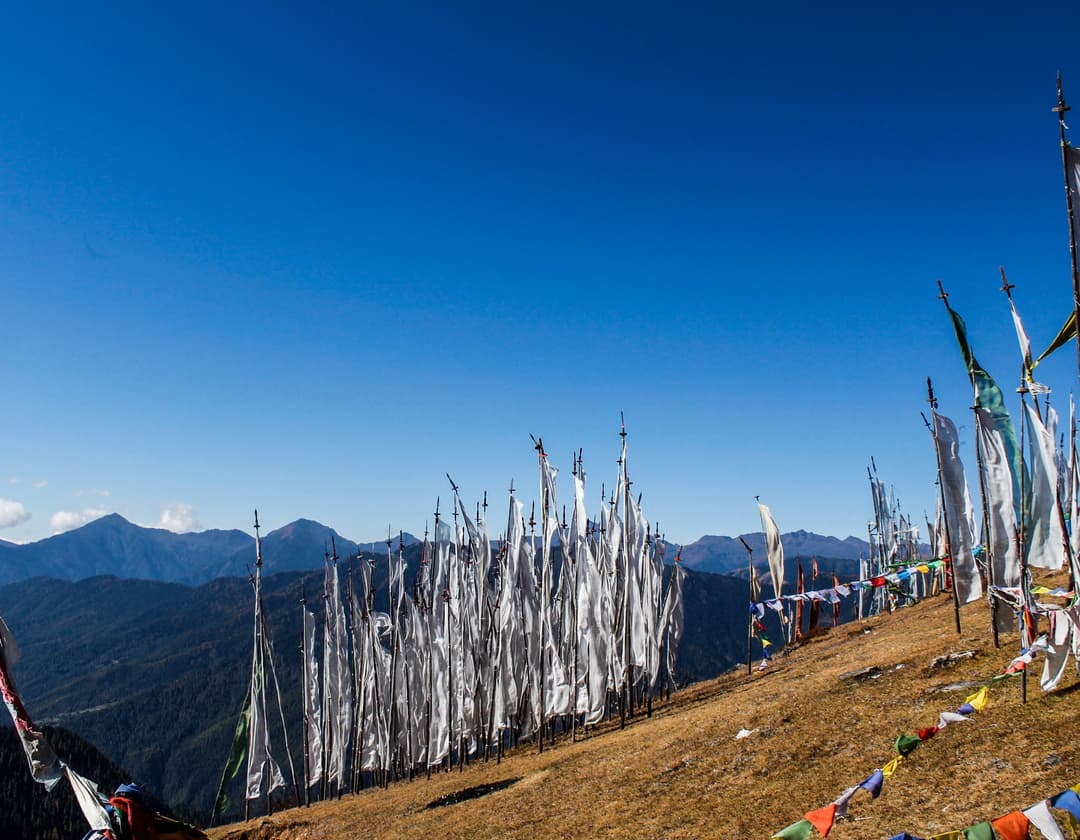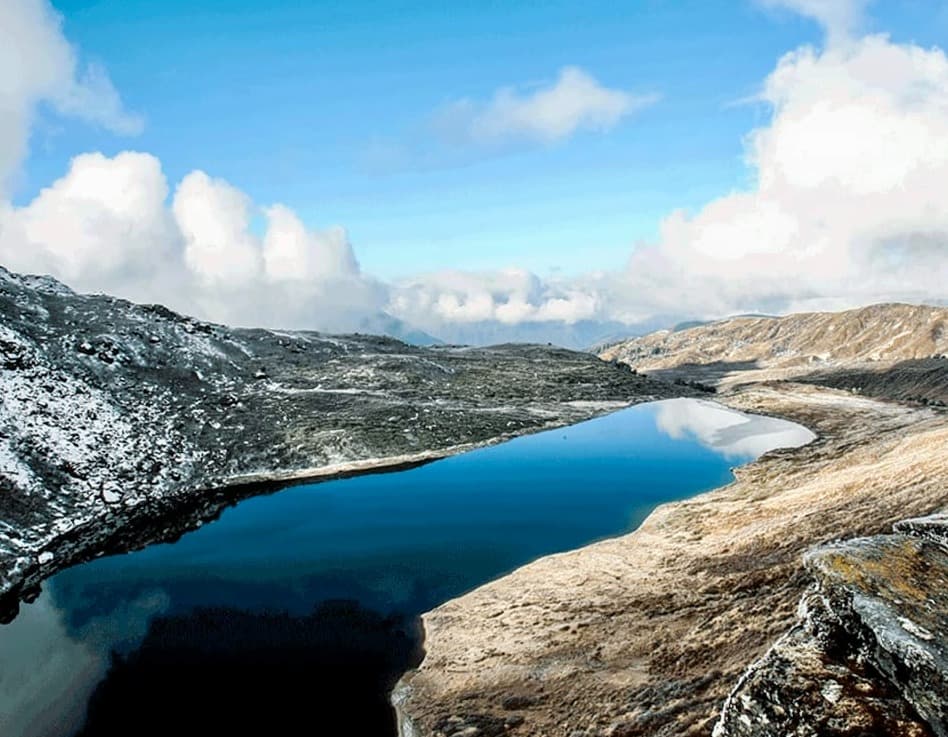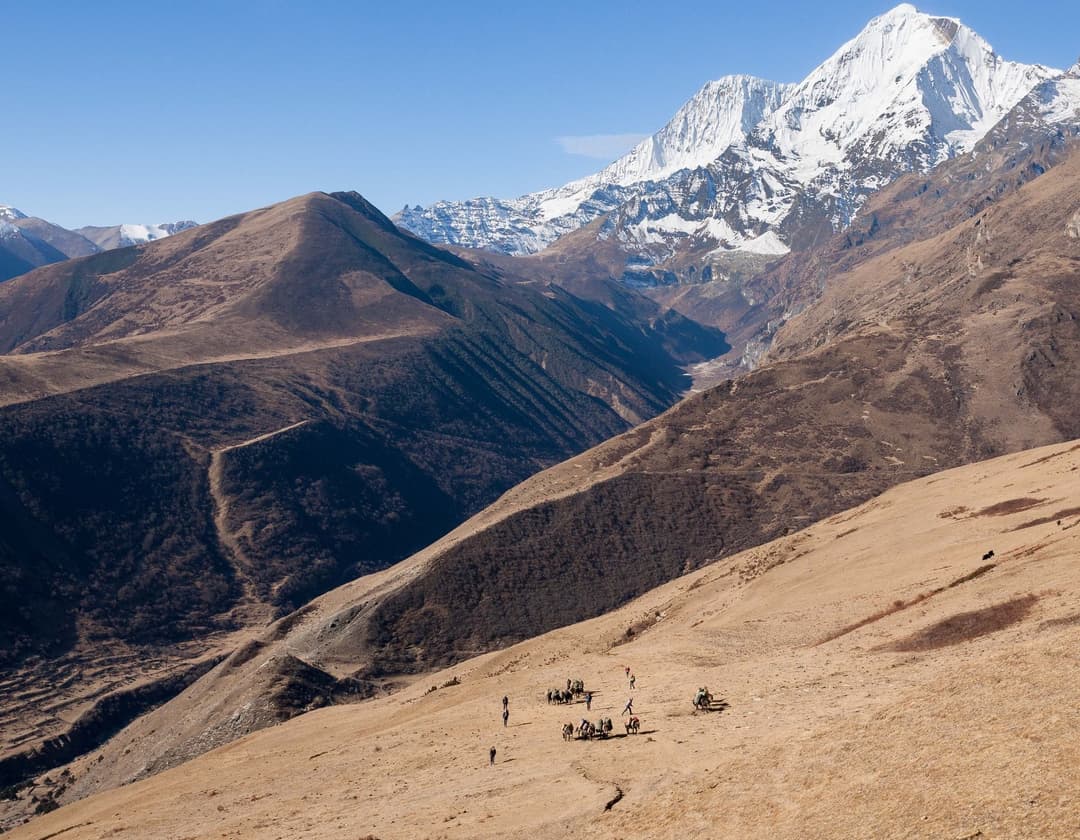Druk Path Trek is a captivating journey that showcases the best of Bhutan’s pristine nature and rich culture. This classic trek connects the historical valleys of Paro and Thimphu, offering trekkers the chance to experience the rugged beauty of the Bhutanese Himalayas. Spanning nine days, the trek navigates through isolated lakes, ancient high-altitude monasteries, and stunning landscapes adorned with rhododendron forests and alpine yak pastures. It's an ideal adventure for those looking to delve into the tranquility of mountainous terrains while exploring significant cultural sites like the iconic Tiger’s Nest Monastery.
As organized by Druk Holidays, the Druk Path Trek is designed to provide an immersive experience into the heart of Bhutanese spirituality and natural splendor. Each day presents a new set of breathtaking vistas and cultural insights, ensuring that every moment of the trek remains etched in your memory. From the serene mornings at lakeside camps to the enriching visits to secluded monasteries, the trek offers a profound connection to the land and its people. Join us for this extraordinary trek and discover why Bhutan is considered the last Shangri-La.
Taktsang Monastery (Tiger’s Nest)
Taktsang Monastery (Tiger’s Nest) is one of the most awe-inspiring and spiritually significant highlights of the Druk Path Trek. Perched on a sheer cliff face nearly 900 meters above the Paro Valley, this iconic monastery is said to be where Guru Rinpoche flew on the back of a tigress to meditate, bringing Buddhism to Bhutan. The ascent to Taktsang is as breathtaking as the destination itself, offering panoramic views and a sense of serenity that transcends the physical exertion required. The intricate architecture and vibrant prayer flags that adorn the monastery create a mesmerizing atmosphere that resonates with every visitor.
- Location: Perched approximately 900 meters above the Paro Valley on a sheer cliff face.
- Historical Significance: Believed to be the site where Guru Rinpoche flew on a tigress's back and meditated, introducing Buddhism to Bhutan.
- Architectural Marvel: The monastery's stunning architecture, clinging to the cliffside, is a testament to Bhutanese ingenuity and spiritual devotion.
- Spiritual Hub: A key spiritual center in Bhutan, attracting pilgrims and visitors from around the world.
- Hiking Experience: The trek to the monastery is both challenging and rewarding, offering sweeping views of the surrounding mountains and valleys.
Taktsang Monastery is not just a highlight of the Druk Path Trek but a profound emblem of Bhutanese culture and spirituality. Its remote location and the physical effort required to reach it only enhance the spiritual payoff, making it a must-visit for anyone seeking to understand the heart and soul of Bhutan. Whether you are a pilgrim, a history enthusiast, or a lover of nature, Taktsang offers a unique and unforgettable experience that epitomizes the mystical allure of Bhutan.
Ancient Dzongs and Temples
The Druk Path Trek offers an unparalleled opportunity to explore Bhutan's ancient dzongs and temples, which serve as both spiritual sanctuaries and historical landmarks. These architectural marvels are strategically located and are integral to Bhutanese culture, offering insights into the country's rich religious traditions and historical narratives. Each dzong and temple has unique features, from intricate woodwork and beautiful frescoes to commanding views of the surrounding landscapes. Visiting these sites provides a deep connection to Bhutan's past and present, making the trek not only a physical journey but also a cultural exploration.
- Strategic Locations: Dzongs are often situated in commanding positions, overlooking valleys and rivers, serving both religious and defensive purposes.
- Architectural Beauty: Known for their massive walls, intricate details, and beautiful courtyards, these structures are masterpieces of Bhutanese architecture.
- Cultural Significance: Dzongs and temples are the epicenters of religious life in Bhutan, hosting numerous festivals and spiritual ceremonies.
- Historical Importance: Many dzongs were built in the medieval period and have stories of ancient warriors and historical events.
- Spiritual Experience: The serene atmosphere and the regular religious practices provide a peaceful and reflective experience for visitors.
The ancient dzongs and temples along the Druk Path Trek are more than just stops along a route; they are profound cultural treasures that offer a window into the soul of Bhutan. They exemplify the harmonious blend of spirituality and historical resilience that characterizes Bhutanese society. For trekkers, these sites provide restful waypoints where one can absorb the tranquility and majesty of Bhutan’s heritage, making every step of the journey both a step back in time and a step deeper into the spiritual heart of the country.
Stunning Lakes
The Druk Path Trek is renowned not only for its cultural and architectural sites but also for its stunning lakes, which are considered sacred and are among the most visually arresting features of the trek. These high-altitude lakes, set against the backdrop of the majestic Himalayas, provide serene spots for rest and reflection, enhancing the spiritual and aesthetic value of the trek.
Each lake along the Druk Path Trek has its own unique charm and legend, contributing to the mystical allure of the journey:
- Jimilangtsho Lake: Known for its large trout population, this lake sits at an altitude of about 3,880 meters. Surrounded by steep hills and a rich variety of alpine flora, Jimilangtsho is a perfect example of the natural beauty that Bhutan has to offer.
- Janetsho Lake: Another serene spot, often visited by yak herders during the summer months. It's a tranquil setting that offers trekkers a peaceful respite along their journey.
- Simkota Lake: Located higher up the trail, Simkota offers dramatic views and is said to be inhabited by a serpent spirit. The rugged terrain around the lake makes it a spectacular spot for photography and nature watching.
The lakes encountered on the Druk Path Trek are not just beautiful natural features; they are steeped in Bhutanese lore and spirituality. Their pristine and tranquil waters reflect the enchanting skies and rugged peaks, offering trekkers moments of peace and reflection. These lakes are essential highlights, providing a refreshing contrast to the rigorous trekking and enriching the overall experience with their breathtaking beauty and serene ambiance.
Flora and Fauna
The Druk Path Trek not only mesmerizes with its cultural and historical sites but also captivates with its rich biodiversity. As trekkers journey through varied ecological zones, from lush valleys to high-altitude meadows, they encounter a diverse array of flora and fauna that highlights Bhutan's commitment to conservation. The trek offers a fantastic opportunity to witness a wide variety of plant life and wildlife in their natural habitats, contributing significantly to the ecological experience of the trek.
- Diverse Flora: The trek passes through several forest types, including blue pine, fir, and rhododendron forests, each supporting a different ecological community.
- Wildlife Sightings: Trekkers might spot rare and exotic wildlife such as the Himalayan blue sheep, snow leopards, and red pandas, which are elusive but integral to the region's biodiversity.
- Birdwatching: Bhutan is a haven for bird enthusiasts, and the Druk Path Trek is no exception. The area is home to numerous bird species, including the black-necked crane, blood pheasant, and Himalayan monal.
- Medicinal Plants: The trail is dotted with numerous species of medicinal herbs and plants, used by local communities for centuries.
- High-Altitude Vegetation: As the trail ascends, the vegetation changes, and trekkers can observe the adaptations of plant life to the harsher conditions of higher altitudes.
The flora and fauna along the Druk Path Trek offer trekkers a profound connection to nature. The diversity of ecosystems encountered on the trail showcases Bhutan's natural wealth and the importance of its preservation. Observing these species in their natural environment not only enhances the trekking experience but also educates and inspires trekkers about the significance of biodiversity and conservation efforts in Bhutan. This rich natural tapestry adds a vital layer of depth to the cultural journey, making the Druk Path Trek a truly holistic adventure.
Panoramic Mountain Views
The Druk Path Trek offers some of the most spectacular panoramic mountain views that are quintessentially Bhutanese. As trekkers ascend the ancient path, they are greeted with breathtaking vistas of the Himalayan range, including several unclimbed peaks that Bhutan is famous for. These views are not just visually stunning but also provide a profound sense of scale and the rugged beauty of the natural world, enhancing the spiritual and physical journey of every trekker.
- Views of Majestic Peaks: The trek provides clear views of prominent Himalayan peaks such as Jomolhari, Gangkar Puensum (the highest unclimbed mountain in the world), and many others.
- Changing Landscapes: As you move through different altitudes, the landscape shifts dramatically, from lush pine forests to stark, majestic high-altitude terrain.
- Sunrise and Sunset: Experience some of the most beautiful sunrises and sunsets, which light up the Himalayan peaks in brilliant colors.
- 360-degree Vistas: Certain points along the trek, like the passes and high ridges, offer 360-degree views that encompass rugged mountain terrain and sweeping valleys.
- Photographic Opportunities: For photography enthusiasts, the panoramic views provide endless opportunities to capture the awe-inspiring beauty of Bhutan’s landscape.
The panoramic mountain views on the Druk Path Trek are a highlight that embodies the essence of trekking in Bhutan. These vistas offer not only a visual feast but also a moment to reflect on the vastness and untouched beauty of the natural world. Each view seems to tell a story of the earth’s formation, the ancient paths trodden by pilgrims, and the serene isolation that has preserved this region for centuries. For many, these mountain views are a defining feature of the trek, offering a rewarding payoff for the physical challenges of the hike and a lasting impression of Bhutan’s majestic wilderness.
Cultural Interaction
The Druk Path Trek offers a unique opportunity for cultural interaction, allowing trekkers to immerse themselves in the deep-seated traditions and daily lives of the Bhutanese people. This trek is not just a journey through the mountains of Bhutan but also a passage through its cultural heartland.
As you trek from Paro to Thimphu, you will encounter remote villages and traditional Bhutanese communities that have maintained their way of life for centuries. These interactions provide a firsthand experience of Bhutan's rich cultural tapestry:
- Local Villages: Trekking through small villages gives you a glimpse into the rural Bhutanese lifestyle, where ancient traditions are still part of daily life.
- Herders' Camps: Meeting nomadic yak herders along the route allows for understanding their nomadic culture, dependent on the cycles of nature for livelihood.
- Cultural Exchanges: Engaging with locals, whether through a shared meal or a night’s stay in a village homestay, offers insights into the customs, beliefs, and hospitality that define Bhutanese culture.
- Traditional Crafts: The trek may also offer chances to see traditional Bhutanese crafts in action, such as weaving or the making of national dress (Gho and Kira).
- Festivals: If your trek coincides with local festivals, you can witness colorful and vibrant celebrations that are integral to Bhutanese culture.
The cultural interactions along the Druk Path Trek enrich the trekking experience, adding layers of understanding and connection to the journey. These encounters with the people and their customs offer a deeper appreciation of how the landscape shapes the cultural identity of Bhutan. They provide a memorable exchange that respects and celebrates the heritage and continuity of Bhutanese traditions, making the Druk Path Trek not just a physical challenge but also a profound cultural immersion.
Phajoding Monastery
The Druk Path Trek provides a wonderful opportunity to visit Phajoding Monastery, a significant spiritual site perched high above the Thimphu Valley. This monastery is not just a place of religious importance; it's also a historical treasure that offers trekkers a serene and contemplative environment, complementing the physical aspect of the trek with spiritual enrichment.
Phajoding Monastery stands as a testament to Bhutanese architectural elegance and religious devotion. Established in the 13th century by Phajo Drugom Zhigpo, a Tibetan Lama who spread the Drukpa Kagyu school of Buddhism in Bhutan, the monastery has since been a place of retreat and meditation for monks. Here are some highlights:
- Spiritual Retreat: Known for its religious significance, Phajoding provides a peaceful retreat for monks and visitors alike, ideal for meditation and reflection.
- Architectural Beauty: The monastery features traditional Bhutanese architecture with intricately painted woodwork, colorful flags, and beautiful prayer wheels.
- Historical Legacy: The site has a rich history linked to the propagation of Buddhism in Bhutan, making it a key point of interest for those keen on religious and historical studies.
- Panoramic Views: From its vantage point, the monastery offers breathtaking views of the capital city below and the surrounding mountains, making it a perfect spot for contemplation and photography.
- Cultural Connection: Visiting Phajoding can provide deeper insights into the spiritual practices and daily lives of the Bhutanese monk community.
Phajoding Monastery is a highlight of the Druk Path Trek that offers a unique blend of spiritual, historical, and cultural experiences. Its serene setting and religious importance make it a soul-enriching stop that enhances the overall trekking experience. Visitors leave with a deeper understanding of Bhutanese Buddhism and the spiritual tranquility that is woven into the fabric of this Himalayan kingdom.
Isolation and Tranquility
The Druk Path Trek is renowned not just for its scenic beauty and cultural significance but also for the profound sense of isolation and tranquility it offers. This trek takes you through some of Bhutan's most pristine and undisturbed natural landscapes, providing a serene escape from the hustle and bustle of modern life.
The isolation of the Druk Path Trek allows for a truly introspective journey:
- Remote Paths: The trail meanders through remote areas that are far removed from the usual tourist trails, offering peace and solitude.
- Natural Beauty: Surrounded by the untouched beauty of the Bhutanese Himalayas, trekkers can fully immerse themselves in nature, experiencing the landscapes in a very personal and intimate way.
- Meditative Environment: The quiet and undisturbed environment supports a meditative experience, encouraging deep reflection and connection with one's inner self.
- Disconnect from the Modern World: The trek provides a rare opportunity to disconnect from digital distractions and reconnect with the natural world, promoting mental and emotional well-being.
- Starry Nights: The isolation also means minimal light pollution, allowing for spectacular stargazing opportunities during the clear Himalayan nights.
The isolation and tranquility of the Druk Path Trek are among its most cherished attributes, offering trekkers a chance to experience peace and solitude amidst some of the world’s most breathtaking landscapes. This journey not only challenges the body but also soothes the soul, providing a perfect balance of adventure and serenity that draws travelers seeking both exploration and introspection.
Best Time for Druk Path Trek
The Druk Path Trek, one of Bhutan's most popular high-altitude treks, can be undertaken at different times of the year, each offering unique experiences and conditions. Here's a breakdown of what to expect in each season:
Spring (March to May)
- Weather: Spring is one of the best times for the Druk Path Trek. The weather is pleasantly mild, and temperatures are comfortable for trekking during the day, though nights can still be chilly, especially at higher altitudes.
- Visibility: Excellent visibility makes this season ideal for photographers and nature lovers looking to capture clear views of the mountainous landscape.
- Flora: This season is particularly beautiful as rhododendrons, magnolias, and other wildflowers are in full bloom, creating a vibrant tapestry of colors along the trails.
Summer (June to August)
- Weather: Summer in Bhutan is marked by the monsoon, which can make trekking conditions challenging due to rain, mud, and potential leeches on the lower trails. However, the higher you go, the less rain tends to be an issue.
- Visibility: Mist and clouds may obscure some views, but the landscape is lush and green, offering a different kind of beauty.
- Considerations: Fewer tourists trek during this season, which might appeal to those seeking solitude.
Autumn (September to November)
- Weather: Autumn rivals spring as the best time to trek the Druk Path. The weather is stable with clear, dry days and crisp temperatures.
- Visibility: Excellent visibility returns, offering grand views of the Himalayan range.
- Cultural Festivals: The autumn season also coincides with several major Bhutanese festivals, including the famous Thimphu Tshechu, adding a rich cultural element to your visit.
Winter (December to February)
- Weather: Winter can be very cold, especially at night, with temperatures dropping below freezing at higher altitudes. Snowfall is common, which can add to the difficulty of the trek.
- Visibility: Days are usually clear and sunny, offering good mountain views, though the air can be quite cold.
- Considerations: Winter is the least popular season for trekking due to the cold, but for those well-prepared, it offers a quiet and serene trekking experience, with fewer tourists on the trail.
Choosing Your Time
- Most Recommended: Spring and autumn are highly recommended due to their favorable weather conditions and the added visual treat of either spring blooms or clear autumn skies.
- Less Crowded Option: Summer and winter present opportunities for those who prefer solitude and are prepared to deal with the challenges of either monsoon rains or cold conditions.
When planning your trek, consider both the climatic conditions and the type of experience you wish to have. Also, align your trek with any cultural interests you might have, particularly if you want to participate in or witness the local festivals.
Important notes on the Druk Path Trek
The Druk Path Trek is a rewarding experience, but it's important to be well-prepared and aware of some essential aspects to ensure a safe and enjoyable journey. Here are some important notes for anyone planning to take on this adventure:
- Altitude Awareness: The trek reaches high altitudes, with some points above 4,000 meters. Acclimatization days are included, but it’s crucial to be aware of the signs of altitude sickness and take appropriate precautions.
- Fitness Level: The trek involves several days of walking through varied terrain, including steep ascents and descents. A good level of fitness is required to enjoy and complete the trek comfortably.
- Weather Conditions: Weather in the mountains can be unpredictable. Be prepared for sudden changes in weather, including rain or snow. Packing appropriate clothing and gear is essential.
- Travel Insurance: Ensure you have comprehensive travel insurance that covers high-altitude trekking and potential medical evacuation.
- Cultural Sensitivity: Bhutan has a deep-rooted cultural heritage. Respecting local customs, traditions, and religious practices is important. Dress modestly and ask permission before photographing people or religious sites.
- Guided Tour Requirement: Bhutan does not permit independent trekking. All treks must be booked through a registered tour operator like Druk Holidays. This ensures safety and provides local knowledge through experienced guides.
- Environmental Care: Bhutan is known for its environmental conservation efforts. Trekkers are encouraged to adhere to leave-no-trace principles to keep the environment pristine. This includes carrying out all your trash and minimizing your ecological footprint.
- Pack Essentials: Besides regular trekking gear, include a water purification system, extra layers for cold weather, sun protection, and a basic first aid kit.
- Permits and Documentation: We will handle the necessary permits and documentation, including your visa and trekking permits. Ensure all your documents are in order before departure.
- Communication: While some parts of the trek may have mobile network coverage, it’s spotty. Prepare for limited access to communication facilities.
These notes are designed to help trekkers prepare adequately for the Druk Path Trek, ensuring a safe, enjoyable, and culturally enriching experience.
The Druk Path Trek is an unparalleled adventure that offers a profound blend of natural beauty, cultural immersion, and personal challenge. As a trekker traverses the rugged terrains of Bhutan, they experience the serenity of remote lakes, the grandeur of the Himalayan peaks, and the rich tapestry of Bhutanese spiritual life through visits to ancient dzongs and monasteries. Each step on the trek is a journey through the heart of Bhutan's heritage, providing an unforgettable exploration of the kingdom's pristine landscapes and vibrant culture. This trek is not just a physical journey but a transformative experience, sure to leave lasting impressions and profound respect for the natural and cultural wonders of Bhutan.


